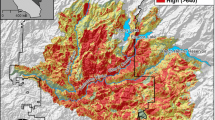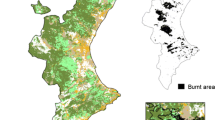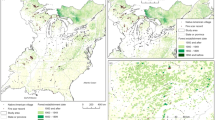Abstract
Large fires and their impacts are a growing concern as changes in climate and land use proceed. The study of large-fire controls remains incipient in comparison with other components of the fire regime. Improved understanding of large-fire size drivers can disclose fire–landscape relationships and inform more sustainable and effective fire management. We used boosted regression tree modeling to identify the variables influent on large-fire size (100–23,219 ha, n = 609) in Portugal (1998–2008) and quantify their relative importance, globally and across the fire-size range. Potential explanatory variables included metrics pertaining to fire weather and antecedent rainfall, burned area composition, fuel connectivity, pyrodiversity (from fire recurrence patterns), topography, and land development. Large fires seldom occurred in the absence of severe fire weather. The fire-size model accounted for 70% of the deviance and included 12 independent variables, of which six absorbed 91% of the explanation. Bottom-up influences on fire size, essentially fuel-related, largely outweighed climate–weather influences, with respective importance of 85 and 15%. Fire size was essentially indifferent to land-cover composition, including forest type, and increased with high fuel connectivity and low pyrodiversity. Relevant synergies between variables were found, either positive or negative, for example, high pyrodiversity buffered the effects of extreme weather on fire size. The relative role of fire-size drivers did not vary substantially with fire size, but fires larger than 500 ha were increasingly controlled by fuel-related variables. The extent of an individual large fire is mainly a function of factors that land-use planning and forest and fuel management can tackle.




Similar content being viewed by others
Notes
Computed from EFFIS—European Forest Fire Information System data supplied by the Joint Research Centre of the European Commission (http://forest.jrc.ec.europa.eu/effis/) for the 1990–2011 period.
References
Anderson WR, Cruz MG, Fernandes PM, McCaw L, Vega JA, Bradstock R, Fogarty L, Gould J, McCarthy G, Marsden-Smedley JB, Matthews S, Mattingley G, Pearce G, van Wilgen B. 2015. A generic, empirical-based model for predicting rate of fire spread in shrublands. Int J Wildland Fire 24:443–60.
Angel S, Parent J, Civco DL. 2010. Ten compactness properties of circles: measuring shape in geography. Can Geogr 54:441–61.
Archibald S, Lehmann CE, Gómez-Dans JL, Bradstock RA. 2013. Defining pyromes and global syndromes of fire regimes. Proc Natl Acad Sci 110:6442–7.
Barros AMG, Pereira JMC. 2014. Wildfire selectivity for land cover type: does size matter? PLoS One 9:e84760.
Barros AM, Pereira JM, Lund UJ. 2012. Identifying geographical patterns of wildfire orientation: a watershed-based analysis. For Ecol Manag 264:98–107.
Barros AM, Pereira J, Moritz MA, Stephens SL. 2013. Spatial characterization of wildfire orientation patterns in California. Forests 4:197–217.
Bird RB, Codding BF, Kauhanen PG, Bird DW. 2012. Aboriginal hunting buffers climate-driven fire-size variability in Australia’s spinifex grasslands. Proc Natl Acad Sci 109:10287–92.
Boer MM, Sadler RJ, Wittkuhn RS, McCaw L, Grierson PF. 2009. Long-term impacts of prescribed burning on regional extent and incidence of wildfires—evidence from 50 years of active fire management in SW Australian forests. For Ecol Manag 259:132–42.
Bowman DM, O’Brien JA, Goldammer JG. 2013. Pyrogeography and the global quest for sustainable fire management. Ann Rev Environ Resour 38:57–80.
Bradstock RA, Cohn JS, Gill AM, Bedward M, Lucas C. 2009. Prediction of the probability of large fires in the Sydney region of south-eastern Australia using fire weather. Int J Wildland Fire 18:932–43.
Collins BM, Miller JD, Thode AE, Kelly M, Van Wagtendonk JW, Stephens SL. 2009. Interactions among wildland fires in a long-established Sierra Nevada natural fire area. Ecosystems 12:114–28.
Curt T, Borgniet L, Bouillon C. 2013. Wildfire frequency varies with the size and shape of fuel types in southeastern France: implications for environmental management. J Environ Manag 117:150–61.
Dennison PE, Moritz MA, Taylor RS. 2008. Evaluating predictive models of critical live fuel moisture in the Santa Monica Mountains, California. Int J Wildland Fire 17:18–27.
Duncan BW, Schmalzer PA. 2004. Anthropogenic influences on potential fire spread in a pyrogenic ecosystem of Florida, USA. Landsc Ecol 19:153–65.
Elith J, Leathwick JR, Hastie T. 2008. A working guide to boosted regression trees. J Anim Ecol 77:802–13.
ESRI. 2011. ArcGIS desktop: release 10. Redlands (CA): Environmental Systems Research Institute Inc.
Evans J. 2011. EVANS TNC modeling tools: ArcGIS-geomorphometry and gradient metrics toolbox. http://evansmurphy.wix.com/evansspatial#!arcgis-gradient-metrics-toolbox/crro.
Faivre N, Roche P, Boer MM, McCaw L, Grierson PF. 2011. Characterization of landscape pyrodiversity in Mediterranean environments: contrasts and similarities between south-western Australia and south-eastern France. Landsc Ecol 26:557–71.
Falk DA, Miller C, McKenzie D, Black AE. 2007. Cross-scale analysis of fire regimes. Ecosystems 10:809–23.
Fang L, Yang J, Zu J, Li G, Zhang J. 2015. Quantifying influences and relative importance of fire weather, topography, and vegetation on fire size and fire severity in a Chinese boreal forest landscape. For Ecol Manag 356:2–12.
Fernandes PM. 2009. Combining forest structure data and fuel modelling to assess fire hazard in Portugal. Ann For Sci 66:415p1–9.
Fernandes PM, Davies GM, Ascoli D, Fernández C, Moreira F, Rigolot E, Stoof K, Vega JA, Molina D. 2013. Prescribed burning in southern Europe: developing fire management in a dynamic landscape. Front Ecol Environ 11(s1):e4–14.
Fernandes PM, Loureiro C. 2013. Fine fuels consumption and CO2 emissions from surface fire experiments in maritime pine stands in northern Portugal. For Ecol Manag 291:344–56.
Fernandes PM, Loureiro C, Guiomar N, Pezzatti GB, Manso F, Lopes L. 2014. The dynamics and drivers of fuel and fire in the Portuguese public forest. J Environ Manag 146:373–82.
Fernandes PM, Loureiro C, Magalhães M, Ferreira P, Fernandes M. 2012. Fuel age, weather and burn probability in Portugal. Int J Wildland Fire 21:380–4.
Fernandes PM, Luz A, Loureiro C. 2010. Changes in wildfire severity from maritime pine woodland to contiguous forest types in the mountains of northwestern Portugal. For Ecol Manag 260:883–92.
Finney MA. 2001. Design of regular landscape fuel treatment patterns for modifying fire growth and behavior. For Sci 47:219–28.
Finney M, Grenfell IC, McHugh CW. 2009. Modeling containment of large wildfires using generalized linear mixed-model analysis. For Sci 55:249–55.
Gill AM, Allan G. 2008. Large fires, fire effects and the fire-regime concept. Int J Wildland Fire 17:688–95.
Guiomar N, Godinho S, Fernandes PM, Machado R, Neves N, Fernandes JP. 2015. Wildfire patterns and landscape changes in Mediterranean oak woodlands. Sci Total Environ 536:338–52.
Guyette RP, Muzika RM, Dey DC. 2002. Dynamics of an anthropogenic fire regime. Ecosystems 5:472–86.
Hargis CD, Bissonette JA, David JL. 1998. The behavior of landscape metrics commonly used in the study of habitat fragmentation. Landsc Ecol 13:167–86.
Hawbaker TJ, Radeloff VC, Stewart SI, Hammer RB, Keuler NS, Clayton MK. 2013. Human and biophysical influences on fire occurrence in the United States. Ecol Appl 23:565–82.
Heyerdahl EK, Brubaker LB, Agee JK. 2001. Spatial controls of historical fire regimes: a multiscale example from the interior west, USA. Ecology 82:660–78.
Hijmans RJ, Phillips S, Leathwick J, Elith J. 2015. dismo: species distribution modeling. R package version 1.0-12.
Holden ZA, Jolly WM. 2011. Modeling topographic influences on fuel moisture and fire danger in complex terrain to improve wildland fire management decision support. For Ecol Manag 262:2133–41.
Holden ZA, Morgan P, Evans JS. 2009. A predictive model of burn severity based on 20-year satellite-inferred burn severity data in a large southwestern US wilderness area. For Ecol Manag 258:2399–406.
Jaeger JAG. 2000. Landscape division, splitting index, and effective mesh size: new measures of landscape fragmentation. Landsc Ecol 15:115–30.
Jenness J. 2013. DEM surface tools for ArcGIS (surface_area.exe). Jenness Enterprises. http://www.jennessent.com/arcgis/surface_area.htm.
Jenness J, Brost B, Beier P. 2013. Land facet corridor designer: extension for ArcGIS. Jenness Enterprises. http://www.jennessent.com/arcgis/land_facets.htm.
Keeley JE, Zedler PH. 2009. Large, high-intensity fire events in southern California shrublands: debunking the fine-grain age patch model. Ecol Appl 19:69–94.
Koutsias N, Arianoutsou M, Kallimanis AS, Mallinis G, Halley JM, Dimopoulos P. 2012. Where did the fires burn in Peloponnisos, Greece the summer of 2007? Evidence for a synergy of fuel and weather. Agric For Meteorol 156:41–53.
Krawchuk MA, Moritz MA. 2011. Constraints on global fire activity vary across a resource gradient. Ecology 92:121–32.
Lee SW, Won MS, Lee JM, Kim HG. 2014. Intermediate-scale analysis of landscape characteristics affecting edge formation in burned forests in Samcheok, Korea. J Mt Sci 11:384–97.
Liu Z, Wimberly MC. 2015. Climatic and landscape influences on fire regimes from 1984 to 2010 in the western United States. PLoS One 10:e0140839.
Liu Z, Yang J, He HS. 2013. Identifying the threshold of dominant controls on fire spread in a boreal forest landscape of northeast China. PLoS One 8:e5618.
Lloret F, Calvo E, Pons X, Díaz-Delgado R. 2002. Wildfires and landscape patterns in the Eastern Iberian Peninsula. Landsc Ecol 17:745–59.
Loepfe L, Martinez-Vilalta J, Oliveres J, Piñol J, Lloret F. 2010. Feedbacks between fuel reduction and landscape homogenisation determine fire regimes in three Mediterranean areas. For Ecol Manag 259:2366–74.
Loepfe L, Rodrigo A, Lloret F. 2014. Two thresholds determine climatic control of forest fire size in Europe and northern Africa. Reg Environ Change 14:1395–404.
Mansuy N, Boulanger Y, Terrier A, Gauthier S, Robitaille A, Bergeron Y. 2014. Spatial attributes of fire regime in eastern Canada: influences of regional landscape physiography and climate. Landsc Ecol 29:1157–70.
McGarigal K, Cushman SA, Neel MC, Ene E. 2002. FRAGSTATS: spatial pattern analysis program for categorical maps. Amherst: University of Massachusetts.
McKenzie D, Miller C, Falk DA. 2011. Toward a theory of landscape fire. In: McKenzie D, Miller C, Falk DA, Eds. The landscape ecology of fire. Ecological Studies Series. New York: Springer Science and Business Media. pp 3–27.
Minnich R, Chou YH. 1997. Wildland fire patch dynamics in the chaparral of Southern California and Northern Baja California. Int J Wildland Fire 7:221–48.
Moritz MA. 1997. Analyzing extreme disturbance events: fire in Los Padres National Forest. Ecol Appl 7:1252–62.
Moser B, Jaeger JA, Tappeiner U, Tasser E, Eiselt B. 2007. Modification of the effective mesh size for measuring landscape fragmentation to solve the boundary problem. Landsc Ecol 22:447–59.
Nunes MCS, Vasconcelos MJ, Pereira JMC, Dasgupta N, Alldredge RJ, Rego FC. 2005. Land cover type and fire in Portugal: do fires burn land cover selectively? Landsc Ecol 20:661–73.
O’Donnell AJ, Boer MM, McCaw WL, Grierson PF. 2014. Scale-dependent thresholds in the dominant controls of wildfire size in semi-arid southwest Australia. Ecosphere 5:art93.
Oliveira TM, Barros AMG, Ager AA, Fernandes PM. 2016. Assessing the effect of fuel break networks to mitigate wildfire area and risk transmission in Portugal. Int J Wildland Fire 25:619–32.
Palheiro PM, Fernandes P, Cruz MG. 2006. A fire behaviour-based fire danger classification for maritime pine stands: comparison of two approaches. For Ecol Manag 234:S54.
Parisien MA, Miller C, Ager AA, Finney MA. 2010. Use of artificial landscapes to isolate controls on burn probability. Landsc Ecol 25:79–93.
Parisien MA, Moritz MA. 2009. Environmental controls on the distribution of wildfire at multiple spatial scales. Ecol Monogr 79:127–54.
Parisien MA, Parks SA, Krawchuk MA, Flannigan MD, Bowman LM, Moritz MA. 2011. Scale-dependent controls on the area burned in the boreal forest of Canada, 1980-2005. Ecol Appl 21:789–805.
Parisien MA, Parks SA, Krawchuk MA, Little JM, Flannigan MD, Gowman LM, Moritz MA. 2014. An analysis of controls on fire activity in boreal Canada: comparing models built with different temporal resolutions. Ecol Appl 24:1341–56.
Parks SA, Parisien MA, Miller C. 2011. Multi-scale evaluation of the environmental controls on burn probability in a southern Sierra Nevada landscape. Int J Wildland Fire 20:815–28.
Parks SA, Parisien MA, Miller C. 2012. Spatial bottom-up controls on fire likelihood vary across western North America. Ecosphere 3:art12.
Parks SA, Holsinger LM, Miller C, Nelson CR. 2015. Wildland fire as a self-regulating mechanism: the role of previous burns and weather in limiting fire progression. Ecol Appl 25:1478–92.
Pausas JG, Keeley JE. 2014. Abrupt climate-independent fire regime changes. Ecosystems 17:1109–20.
Pereira JMC, Santos MTN. 2003. Fire risk and burned area mapping in Portugal. Lisbon: Direcção-Geral das Florestas.
Peters DP, Pielke RA, Bestelmeyer BT, Allen CD, Munson-McGee S, Havstad KM. 2004. Cross-scale interactions, nonlinearities, and forecasting catastrophic events. Proc Natl Acad Sci USA 101:15130–5.
Peterson GD. 2002. Contagious disturbance, ecological memory, and the emergence of landscape pattern. Ecosystems 5:329–38.
Pôças I, Cunha M, Pereira LS. 2011. Remote sensing based indicators of changes in a mountain rural landscape of Northeast Portugal. Appl Geogr 31:871–80.
Price OF, Bradstock RA. 2010. The effect of fuel age on the spread of fire in sclerophyll forest in the Sydney region of Australia. Int J Wildland Fire 19:35–45.
R Core Team. 2015. R: A language and environment for statistical computing. Vienna: R Foundation for Statistical Computing.
Rempel RS, Elkie PC, Carr A. 1999. Patch analyst user’s manual: a tool for quantifying landscape structure. Thunder Bay: Ontario Ministry of Natural Resources, Boreal Science, Northwest Science & Technology.
Ryu SR, Chen J, Zheng D, Lacroix JJ. 2007. Relating surface fire spread to landscape structure: an application of FARSITE in a managed forest landscape. Landsc Urban Plan 83:275–83.
San-Miguel-Ayanz J, Moreno JM, Camia A. 2013. Analysis of large fires in European Mediterranean landscapes: lessons learned and perspectives. For Ecol Manag 294:11–22.
Sánchez B, Kahabka H. 2008. 2006. GMES fast track service on land monitoring. High-resolution core land cover data built-up areas including degree of soil sealing. Delivery Report Portugal. Copenhagen: EEA.
Schoenberg FP, Peng R, Huang Z, Rundel P. 2003. Detection of non-linearities in the dependence of burn area on fuel age and climatic variables. Int J Wildland Fire 12:1–6.
Slocum MG, Beckage B, Platt WJ, Orzell SL, Taylor W. 2010. Effect of climate on wildfire size: a cross-scale analysis. Ecosystems 13:828–40.
Strauss D, Bednar L, Mees R. 1989. Do one percent of the forest fires cause ninety-nine percent of the damage? For Sci 35:319–28.
Sullivan AL. 2009. Wildland surface fire spread modelling, 1990–2007. 2: empirical and quasi-empirical models. Int J Wildland Fire 18:369–86.
Syphard AD, Radeloff VC, Keeley JE, Hawbaker TJ, Clayton MK, Stewart SI, Hammer RB. 2007. Human influence on California fire regimes. Ecol Appl 17:1388–402.
Tabachnick BG, Fidell LS. 2001. Using multivariate statistics. 4th edn. Needham Heights (MA): Allyn and Bacon.
Turner MG. 2010. Disturbance and landscape dynamics in a changing world. Ecology 91:2833–49.
Turner MG, Romme WH, Gardner RH, Hargrove WW. 1997. Effects of fire size and pattern on early succession in Yellowstone National Park. Ecol Monogr 67:411–33.
Urbieta IR, Zavala G, Bedia J, Gutiérrez JM, San Miguel-Ayanz J, Camia A, Keeley JE, Moreno JM. 2015. Fire activity as a function of fire–weather seasonal severity and antecedent climate across spatial scales in southern Europe and Pacific western USA. Environ Res Lett 10:114013.
Vázquez A, Pérez B, Fernández-González F, Moreno JM. 2002. Recent fire regime characteristics and potential natural vegetation relationships in Spain. J Veg Sci 13:663–76.
Vega-García C, Chuvieco E. 2006. Applying local measures of spatial heterogeneity to Landsat-TM images for predicting wildfire occurrence in Mediterranean landscapes. Landsc Ecol 21:595–605.
Verburg PH, van Berkel DB, van Doorn AM, van Eupen M, van den Heiligenberg HA. 2010. Trajectories of land use change in Europe: a model-based exploration of rural futures. Landsc Ecol 25:217–32.
Verdú F, Salas J, Vega-García C. 2012. A multivariate analysis of biophysical factors and forest fires in Spain, 1991–2005. Int J Wildland Fire 21:498–509.
Viedma O, Angeler DG, Moreno JM. 2009. Landscape structural features control fire size in a Mediterranean forested area of central Spain. Int J Wildland Fire 18:575–83.
Viedma O, Quesada J, Torres I, De Santis A, Moreno JM. 2015. Fire severity in a large fire in a Pinus pinaster forest is highly predictable from burning conditions, stand structure, and topography. Ecosystems 18:237–50.
Wotton BM. 2009. Interpreting and using outputs from the Canadian Forest Fire Danger Rating System in research applications. Environ Ecol Stat 16:107–31.
Wu J. 2004. Effects of changing scale on landscape pattern analysis: scaling relations. Landsc Ecol 19:125–38.
Acknowledgements
This study contributes to project SUSTAINSYS—Environmental Sustainable Agro-Forestry Systems (NORTE-07-0124-FEDER-0000044), financed by the European Regional Development Fund (ERDF) through the North Operational Regional Programme (ON.2) and by national funds through Fundação para a Ciência e a Tecnologia (FCT). We thank Erica Smithwick and two anonymous reviewers for their useful comments that have improved the manuscript.
Author information
Authors and Affiliations
Corresponding author
Additional information
Author contributions
PMF conceived the study, performed research, and wrote the paper. TMH, NG, CL, and AMGB analyzed data and contributed to writing.
Electronic supplementary material
Below is the link to the electronic supplementary material.
Rights and permissions
About this article
Cite this article
Fernandes, P.M., Monteiro-Henriques, T., Guiomar, N. et al. Bottom-Up Variables Govern Large-Fire Size in Portugal. Ecosystems 19, 1362–1375 (2016). https://doi.org/10.1007/s10021-016-0010-2
Received:
Accepted:
Published:
Issue Date:
DOI: https://doi.org/10.1007/s10021-016-0010-2




